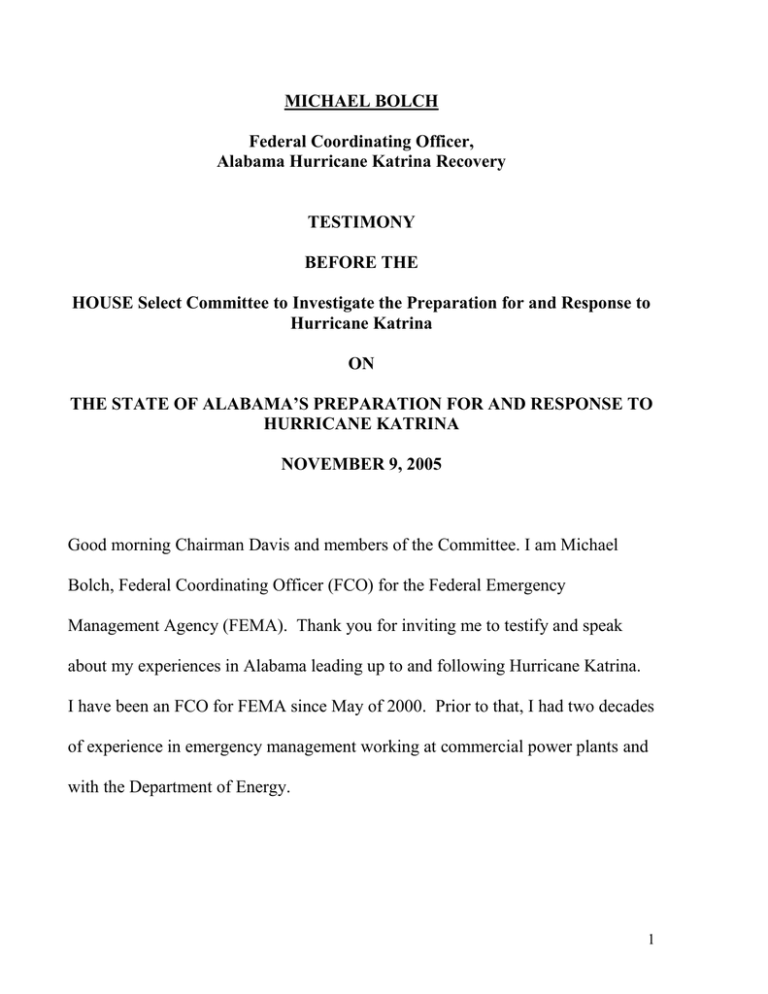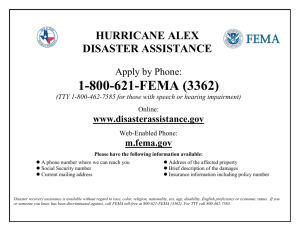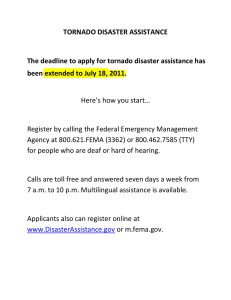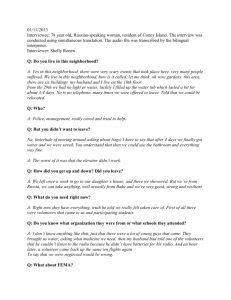MICHAEL BOLCH Federal Coordinating Officer, Alabama Hurricane Katrina Recovery
advertisement

MICHAEL BOLCH Federal Coordinating Officer, Alabama Hurricane Katrina Recovery TESTIMONY BEFORE THE HOUSE Select Committee to Investigate the Preparation for and Response to Hurricane Katrina ON THE STATE OF ALABAMA’S PREPARATION FOR AND RESPONSE TO HURRICANE KATRINA NOVEMBER 9, 2005 Good morning Chairman Davis and members of the Committee. I am Michael Bolch, Federal Coordinating Officer (FCO) for the Federal Emergency Management Agency (FEMA). Thank you for inviting me to testify and speak about my experiences in Alabama leading up to and following Hurricane Katrina. I have been an FCO for FEMA since May of 2000. Prior to that, I had two decades of experience in emergency management working at commercial power plants and with the Department of Energy. 1 Since becoming an FCO, I have overseen 22 major disasters. The FCO establishes and sets up a local disaster field office, oversees the team of disaster workers who assemble and work out of that office, and serves as the Disaster Recovery Manager. Additionally, the FCO represents the President at a disaster site, meeting with high-level elected officials, including the Governor, Members of Congress, Mayors, and other local officials, as well as the media, to provide up-to-date information. At its peak, I managed a staff of 577 federal disaster workers in the Alabama field office. In preparation for major hurricanes such as Katrina, FEMA works in close partnership with the State Office of Emergency Management. State and local officials carry out the bulk of the work, providing preparedness information and making preparations for sheltering. FEMA can support state and local governments in these efforts by bringing to the table basic commodities such as water, food and ice when the State is unable to do so. Distribution of such commodities to disaster victims post event is accomplished at the State’s direction. Whenever possible, including prior to Hurricane Katrina, key FEMA representatives also co-locate with State operations at the Emergency Operations Center prior to the storm to ensure coordination of planning and preparedness efforts and to speed response operations in the aftermath of a storm. State and 2 local operations are further supported by resources at the Regional Office and the National Response Coordination Center at FEMA Headquarters both of which are activated in anticipation of a large scale hurricane to monitor needs and coordinate the response. After the storm, the State gathers information from its network of local emergency managers and officials regarding damage and critical needs. The State assesses the level of damage, prioritizes critical needs, deploys its own assets accordingly and if needed, requests additional federal support through FEMA. My personal experience preparing for and responding to Hurricane Katrina in Alabama demonstrated first hand to me the strong working relationship that exists between FEMA and the State of Alabama. Overall, the response to Hurricane Katrina in Alabama was well organized and sufficiently managed. Within the first few days after the disaster was declared, FEMA provided more than 11.2 million pounds of ice (280 trucks), 836 thousand gallons of water (186 trucks), and more than a million meals-ready-to-eat (103 trucks) in response to the State’s requests. In addition we provided cots, blankets and other essential items to support sheltering efforts. 3 We must remember that Katrina has been the largest and most complex disaster this country has ever experienced. We need to keep in mind that—although you don’t hear much about it lately—FEMA and the State and local partners do a lot good in terms of helping victims put their lives back together. At its peak, more than 5,421 people were in shelters across the state. That number is now down to six. More than 112 thousand people applied for FEMA assistance and we have disbursed over $110 million in aid. In addition, we have placed 2,123 individuals and families in mobile homes or travel trailers and have 170 others located in other federal housing. And, in another milestone, more than 90 percent of the massive debris removal effort in Alabama is complete. Our Public Assistance program, which helps local governments and eligible private non profits to fund debris removal as well as emergency costs and repairs to infrastructure, has processed 733 project worksheets—more than 73 percent of the applications, obligated more than $26 million, and continues to support the state in rebuilding those critical areas damaged by this massive storm. 4 Alabama not only has a Presidential Declaration for Hurricane Katrina, all 67 counties are included in the emergency disaster declaration for those states hosting evacuees from devastated areas of Mississippi, Louisiana, and Texas. More than 26 thousand households from those three states are registered with FEMA and living in Alabama. FEMA is supporting the State of Alabama in its continuing efforts to provide housing and services to this population as well. Additionally, FEMA representatives are already in the field working with state and local officials to identify potential mitigation projects that will lessen damage from futures events. I am proud of the work that we do at FEMA. Thank you for giving me the opportunity to testify today. I would be pleased to answer any questions you may have. 5







